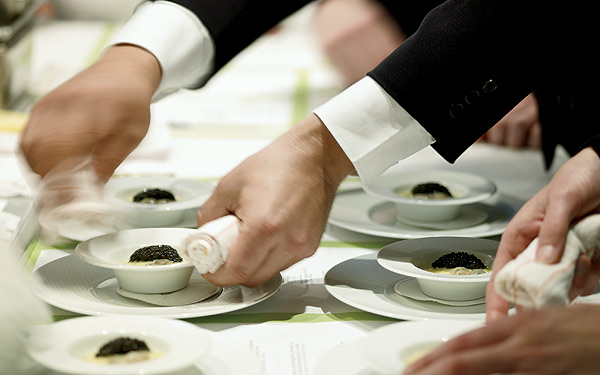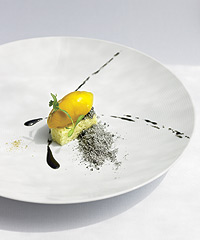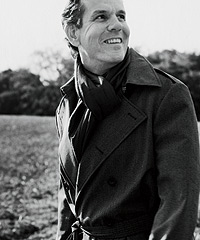
Keller’s “oysters and pearls” at The French Laundry
|
|
If you called The French Laundry the nation’s best restaurant, you would get few arguments. Thomas Keller’s Napa Valley stunner opened in 1994 and has since won every award possible. It also happens to be the place where, under Keller’s tutelage, Grant Achatz’s learning curve took flight. After four years in Keller’s meticulous kitchen (1997–2001), Achatz lit out for Trio in Evanston, where he did a 180 in terms of style—a style that he perfected in 2005 when he launched Alinea. On the surface, it’s difficult to understand how one man’s four years at The French Laundry led to Alinea. After all, the former’s contemporary American cuisine is extravagant but solidly based in French technique; the latter is known for its daring, high-tech creations. I decided to visit the two establishments in the same week to see if I could better understand how Achatz got from there to here—and, of course, to see how the mentor and the protégé compared. (For an account of Achatz’s remarkable fight against tongue cancer, see Burned.)
THE FRENCH LAUNDRY may be the nation’s culinary mecca, but Keller is an unassuming guy who claims he doesn’t believe in creativity. “I think it’s overblown,” Keller says, “—a term people use to define being artistic. Inspiration becomes interpretation. It’s what you do with it.” And what he does with interpretation puts him in stark contrast to that other sturdy pillar of California cooking, Chez Panisse, Alice Waters’s beloved landmark in Berkeley. Hand Waters a perfect peach and she puts it on a plate; Keller would make peach gelée to accompany foie gras terrine.
Interpretation is what he’s perfected in his former steam laundry space in Yountville. Now in its 14th year, The French Laundry occupies a rustic stone and wood building equipped with a second-floor deck and a simple wooden balustrade. Across the street is a garden that spans nearly three acres; Keller even has a gardener on his payroll. The restaurant’s interior is subdued, down to the white Limoges porcelain, accented by a view of the hills through the windows and French doors. All told, the place is nothing like the sleek ultramodernity of Alinea (or Keller’s Per Se in Manhattan). Still, the prices are nothing if not up to date—the daily chef-tasting and vegetable-tasting menus are the only options at The French Laundry and come at a steep $240 per person (includes service but not wine). Definitely not for the faint of wallet.
|
|
Keller continues to experiment with flavors in ways few chefs would dare, much less manage to perfect, but I’ve always thought that his true genius was his understanding of texture. When I first tasted his famous “oysters and pearls” creation at Per Se, I knew I was right. And, of course, it’s just as stunning at The French Laundry, where the dish originated. Keller enhances pearl tapioca sabayon with vermouth and tops it with lightly poached oysters and a quenelle of California white sturgeon caviar. A sublime, masterful blending of textures so gentle they practically float on the tongue.
Even so, the most memorable dish on my visit was . . . chicken. A sous-vide cooked breast, from a hen fattened on milk, came with smoked paprika sauce and globe artichokes. The ivory white meat was more succulent, tender, and delicate than any bird I’ve had anywhere—a triumph of texture and taste. Another fine dish, jamón ibérico with soft cubes of griddled acorn flan, made me smile: Hard acorns are what Spanish pigs eat to give jamón ibérico its unparalleled nutty flavor. This is just the kind of playful deconstruction that Achatz has patented at Alinea. Of course, at The French Laundry, it’s an in-joke that few diners will get; at Alinea, they would explain it to you.
On the drive to the restaurant, I noticed waves of mustard plants in the vineyards. For dessert, when I got the apple bavarois surrounded by cinnamon sablé (here, sandlike cinnamon grains) and accompanied by subtle Dijon mustard ice cream and crystallized Napa Valley mustard blossoms, I truly got it. Keller draws inspiration—and ingredients—from all around him. At heart, he’s just doing California country French cuisine: balanced, textured, and deceptively simple. He’s got the resources, the flawless technique, the unpretentious slant, and the focus to make it all work.
* * *
So what does all this have to do with ALINEA? Grant Achatz uses technology to tinker endlessly with food to reach the same goal as Keller—perfection—but from a completely different perspective. Keller’s impeccable French technique and controlled interpretation seem to be Achatz’s starting point. For example, Keller’s signature amuse—a salmon cornet made with salmon tartare over red onion crème fraîche served in a sesame tuile—takes French components and injects a modern sensibility to create what is basically a gussied-up ice-cream cone. This kind of whimsical gesture seems almost quaint when compared to Achatz’s take on the same idea: One recent palate teaser wraps a sugar tuile around coconut pudding topped with steelhead caviar. The whole contraption is ingeniously attached to a vanilla bean—and, of course, it comes with instructions from the waiter: Slide the pudding off the bean in one bite; savor the vanilla scent; be careful to not eat the bean. Achatz has pushed a similar concept to a radically different level.
I first encountered Achatz’s revolutionary style, what he calls “progressive American cooking,” in 2001 when he bolted The French Laundry for Trio in Evanston. Fresh from his Keller experience (and four life-changing days in Ferran Adrià’s El Bulli kitchen), Achatz went to work deconstructing familiar dishes and recombining them in dazzling new ways while keeping flavors natural to the senses. When I first tasted his ravioli filled with liquid black truffle at Trio, I sensed that Achatz had fundamentally departed from Keller. This new cuisine was the future, and I said so.
Achatz predicted aroma would be the next big trend, and by 2005, when he opened Alinea, he was infatuated with the idea. Other chefs have been on a similar track, including Daniel Patterson, whose stunning two-year-old Coi in San Francisco earned a Michelin star in 2007. Coi’s waiters may instruct you to dab essential oils of grapefruit, ginger, black pepper, and tarragon on your wrist as a prelude to an appetizer made with the same ingredients. (Patterson, incidentally, is so preoccupied with the intersection of aroma and flavor, he has written a book about it and peddles Coi Perfume at his nine-table spot.)
“You eat with your eyes first, then your nose; then you finally get to the taste itself,” said my waiter at Alinea on my most recent visit. Such was my introduction to a strange-looking presentation sitting on a pillow filled with nutmeg and mace air. The weight of the dish slowly deflates the pillow, releasing the spice aroma. The rest of the course involves navy bean purée with crispy pancetta and Guinness beer foam, sherry vinegar and maple syrup emulsion, and all manner of never-before-seen garnishes—tomato leathers, for instance. Sounds like a mess, but it was the opposite: a wonder. The bean purée alone was spectacular, unbelievably smooth and savory—mellow under ethereal Guinness foam. Altogether, stunning combinations.
But that was child’s play compared with a smoked salmon and salsify dish. “It may look like a Tater Tot,” the waiter said. “Actually, it’s crusted salsify with bell pepper, garlic, chive, parsley, ginger, and red onion.” Oh, of course. He went on about how all the same flavors were in dehydrated form on the plate: a transparent garlic chip, dill sauce, picholine olive sauce, something made with maltodextrin . . . This dish had so many parts—I counted 15—that the waiter almost forgot to mention the salmon. It’s an insanely complicated preparation, the kind of thing that would never appear on a French Laundry menu in a million years, but strip away all the noise and you’ve got the same mastery of flavors and textures—a discipline that can be attributed to Keller, but the execution is pure Achatz.
A relatively simple presentation of persimmon, carrot, and a spice strip comes as a relief. Then again, that strip is on a little pin that you’re supposed to press against the roof of your mouth with your tongue until the strip begins to melt. What you get is sweet brown spice (allspice, clove, cinnamon) that enters your nasal cavity and stays there through the whole course. “Careful you don’t stick yourself with the pin,” our waiter says. I was so nervous about an accidental piercing, I forgot to note the two forms of persimmon involved, let alone
appreciate the powder of freeze-dried carrots and pistachio brittle. Fortunately, I remembered to pop the little yellow ball encapsulating ginger tea into my mouth. This is what passes for simple at Alinea.
* * *
The disciplined son of a marine captain, Keller is revered, if not copied, by fellow chefs. Even the contentious French and the foulmouthed Anthony Bourdain have never trashed him. Joining Ducasse and Robuchon as one of only three chefs in the world to have two restaurants simultaneously rated three stars by Michelin (Per Se is his other one), Keller has certainly earned everyone’s respect. He’s also reaching a wider audience after lending his talents to Pixar’s Ratatouille as executive chef and ratatouille designer.
But Grant Achatz has almost managed to make his mentor look like an old fogy. Alinea achieves everything The French Laundry does, but it does so from a more interesting angle: by applying the endless possibilities of science. Anyone who can manipulate flavors, aromas, and textures with high-tech chemistry and make it taste every bit as good as Thomas Keller’s food is a genius. Achatz, through his experiences and his creativity, has molded himself into an ideal combination of tradition and innovation. He’s the perfect chef for the 21st century.
THE SKINNY
THE FRENCH LAUNDRY 6640 Washington St., Yountville, Calif.; 707-944-2380 Tip Exactly two months before you want to visit, start speed-dialing at 10 a.m. Pacific time. FL gets 400 to 500 calls for reservations daily. Hours Lunch Friday-Sunday, dinner nightly Tab (without wine or tax) $240 (includes tip)
ALINEA 1723 N. Halsted St.; 312-867-0110 Tip Wine descriptions by sommelier Joseph Catterson or other staff are wonderfully informative and sometimes hilarious. Hours Dinner Wednesday-Sunday Tab (without wine, tax, or tip) $145 or $195
Photography: (Images 1 & 2) Deborah Jones; (Image 3) Jonathan Skow/Corbis




